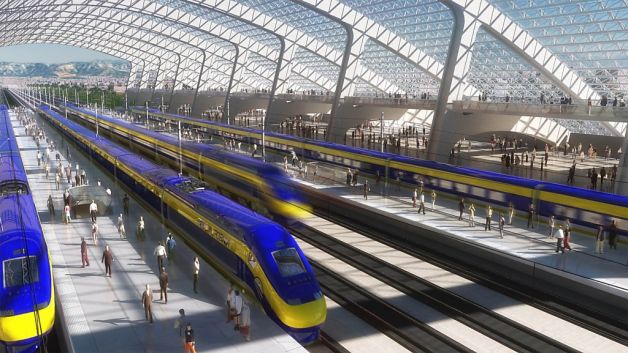Happening Now
And, finally, politicians wavered in their support...
February 25, 2014
Written By Sean Jeans Gail

Sometimes it seems like America has lost the ability to do truly big things. Previous generations carved out the Erie Canal, built the transcontinental railroad, laid the interstate highway, erected the Hoover Dam—heck, they sent people to the moonbecause it was hard. Nowadays, it seems like the best the traveling public can hope for is some sort of new mobile phone app.
In today’s San Francisco Examiner, Thea Selby—a member of the advisory board for the California High Speed Rail Authority—looks to history to provide context for the difficulties that have risen up to confront the 220 mph rail corridor that would connect San Francisco, Los Angeles, and a dozen cities in between. Looking at how the Golden Gate Bridge was built demonstrates that megaprojects have always been bedeviled by doubters, naysayers, and second guessing:
Once the voters approved a bond, financing was neither clear nor easy to come by. Ferry companies and others launched lawsuits to stop the bonds from being issued. There were no companies willing to take on the issuance of the bond until Bank of America stepped up.
Cost estimates went up from conception to design to construction, to the consternation of politicians. The original cost estimate was $17 million. That amount almost doubled to $32 million, and the final cost ended up coming in at $35 million. Legal challenges were continuous. More than 2,000 suits were filed against the Golden Gate Bridge.
Another infrastructure project’s cost overruns affected the Golden Gate Bridge. Strauss and City Engineer Michael O’Shaughnessy issued the proposal to build the bridge in 1921, but O’Shaughnessy came out against construction of it in 1930, as his own project, building the Hetch Hetchy water system, was wildly over its budget.
And, finally, politicians wavered in their support.
Sound familiar? Substitute “high speed rail” for “Golden Gate Bridge,” and you’ve pretty much just described the last five years of difficulties faced by California’s statewide high speed rail system. But Selby’s history also provides hope:
And yet, with Strauss’ perseverance and San Francisco’s need to be connected to the north—as evidenced by the 15-mile backup of cars waiting for the ferry to Sausalito on Labor Day 1930—the bridge was built. Last year, we celebrated its 75th birthday—the anniversary of an engineering wonder, one of the Seven Wonders of the modern world.
This is why the project must go forward. The state will add 12 million new Californians in the coming three decades, and the existing transportation infrastructure can barely handle the current stresses. Something needs to be built, andthe state would have to spend $150 billion to build the equivalent capacity that the high speed service would provide (4,300 new-lanes miles of highway, 115 additional gates at California airports and 4 new airport runways). It's not going to be easy, because it never is. But 75 years from now, let's have them say we made the right choice.
"The National Association of Railroad Passengers has done yeoman work over the years and in fact if it weren’t for NARP, I'd be surprised if Amtrak were still in possession of as a large a network as they have. So they've done good work, they're very good on the factual case."
Robert Gallamore, Director of Transportation Center at Northwestern University and former Federal Railroad Administration official, Director of Transportation Center at Northwestern University
November 17, 2005, on The Leonard Lopate Show (with guest host Chris Bannon), WNYC New York.
Comments